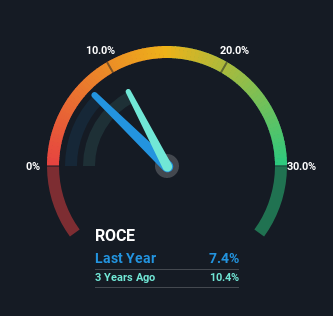Barnes Group's (NYSE:B) Returns On Capital Not Reflecting Well On The Business
When researching a stock for investment, what can tell us that the company is in decline? More often than not, we'll see a declining return on capital employed (ROCE) and a declining amount of capital employed. This indicates to us that the business is not only shrinking the size of its net assets, but its returns are falling as well. And from a first read, things don't look too good at Barnes Group (NYSE:B), so let's see why.
Understanding Return On Capital Employed (ROCE)
Just to clarify if you're unsure, ROCE is a metric for evaluating how much pre-tax income (in percentage terms) a company earns on the capital invested in its business. Analysts use this formula to calculate it for Barnes Group:
Return on Capital Employed = Earnings Before Interest and Tax (EBIT) ÷ (Total Assets - Current Liabilities)
0.074 = US$158m ÷ (US$2.4b - US$313m) (Based on the trailing twelve months to March 2023).
Thus, Barnes Group has an ROCE of 7.4%. Ultimately, that's a low return and it under-performs the Machinery industry average of 11%.
View our latest analysis for Barnes Group
Above you can see how the current ROCE for Barnes Group compares to its prior returns on capital, but there's only so much you can tell from the past. If you'd like, you can check out the forecasts from the analysts covering Barnes Group here for free.
What Does the ROCE Trend For Barnes Group Tell Us?
In terms of Barnes Group's historical ROCE movements, the trend doesn't inspire confidence. To be more specific, the ROCE was 10% five years ago, but since then it has dropped noticeably. On top of that, it's worth noting that the amount of capital employed within the business has remained relatively steady. Since returns are falling and the business has the same amount of assets employed, this can suggest it's a mature business that hasn't had much growth in the last five years. If these trends continue, we wouldn't expect Barnes Group to turn into a multi-bagger.
In Conclusion...
In summary, it's unfortunate that Barnes Group is generating lower returns from the same amount of capital. It should come as no surprise then that the stock has fallen 25% over the last five years, so it looks like investors are recognizing these changes. Unless there is a shift to a more positive trajectory in these metrics, we would look elsewhere.
Barnes Group does have some risks though, and we've spotted 2 warning signs for Barnes Group that you might be interested in.
For those who like to invest in solid companies, check out this free list of companies with solid balance sheets and high returns on equity.
Have feedback on this article? Concerned about the content? Get in touch with us directly. Alternatively, email editorial-team (at) simplywallst.com.
This article by Simply Wall St is general in nature. We provide commentary based on historical data and analyst forecasts only using an unbiased methodology and our articles are not intended to be financial advice. It does not constitute a recommendation to buy or sell any stock, and does not take account of your objectives, or your financial situation. We aim to bring you long-term focused analysis driven by fundamental data. Note that our analysis may not factor in the latest price-sensitive company announcements or qualitative material. Simply Wall St has no position in any stocks mentioned.
Join A Paid User Research Session
You’ll receive a US$30 Amazon Gift card for 1 hour of your time while helping us build better investing tools for the individual investors like yourself. Sign up here

